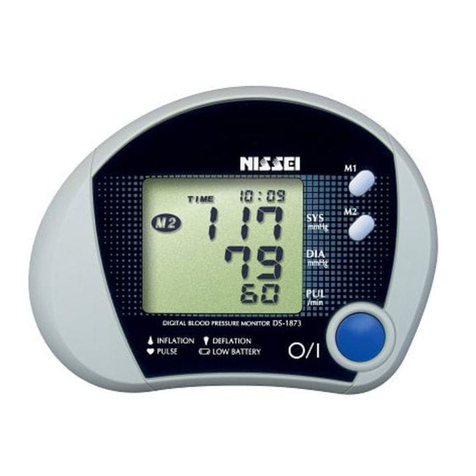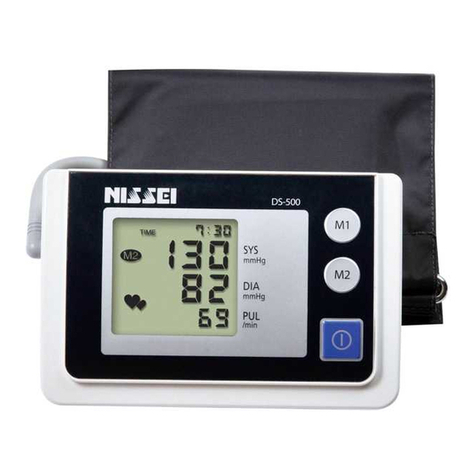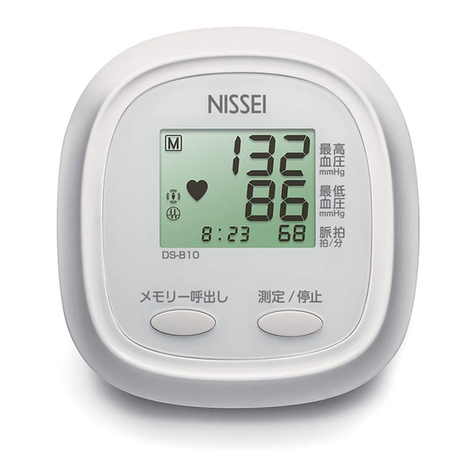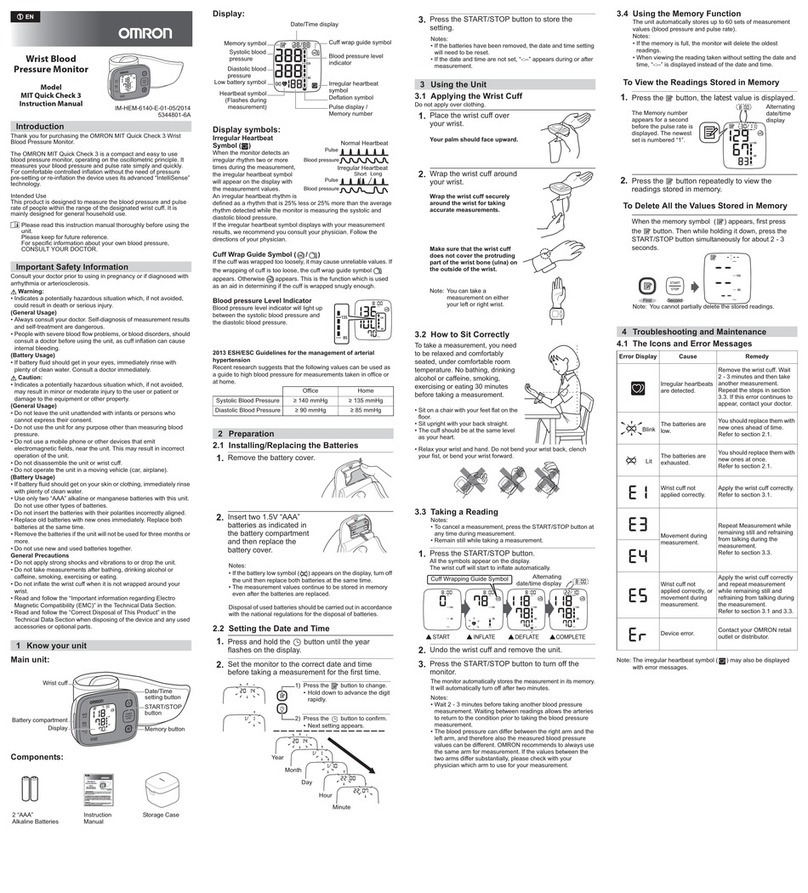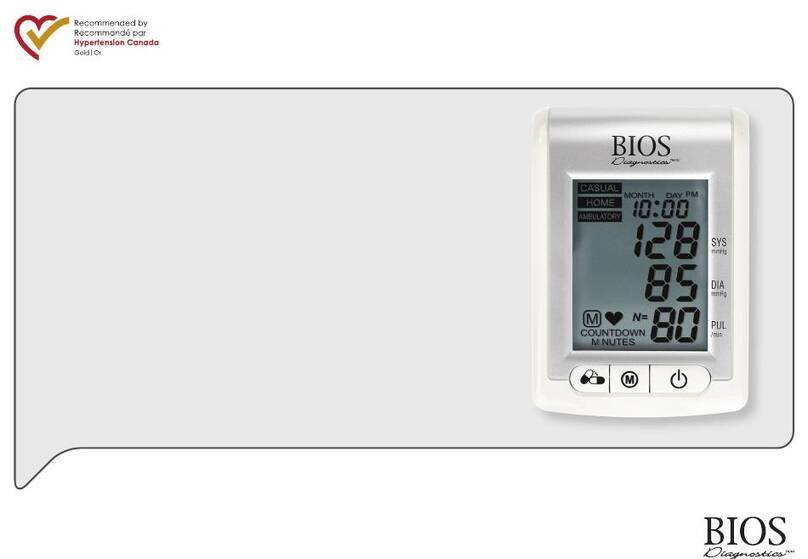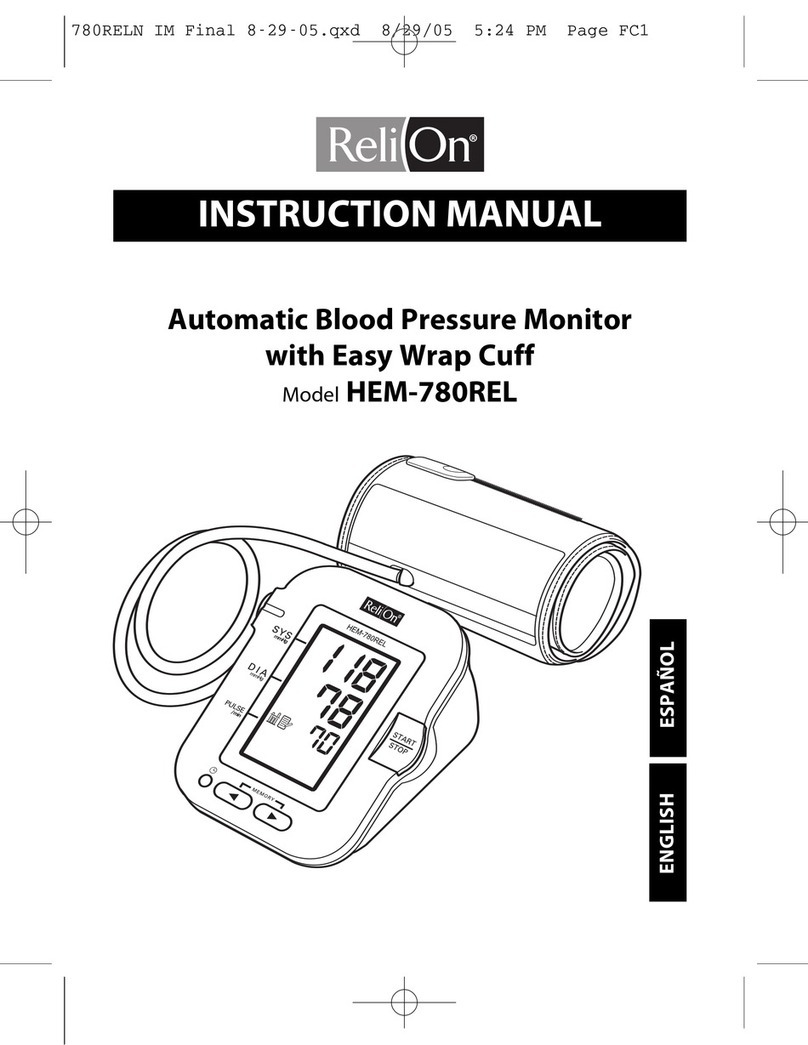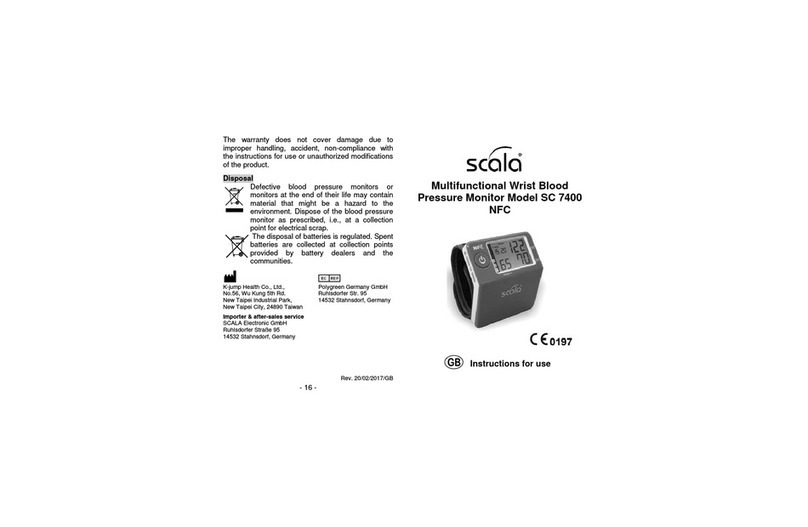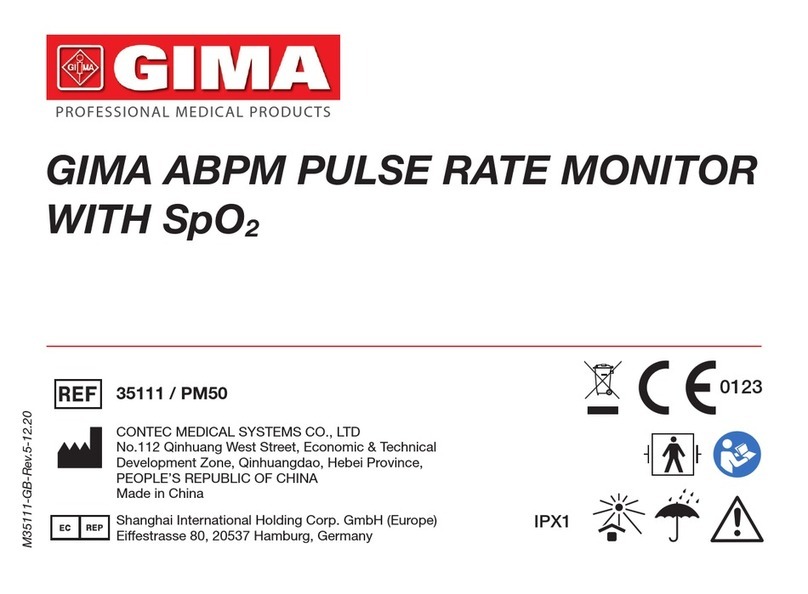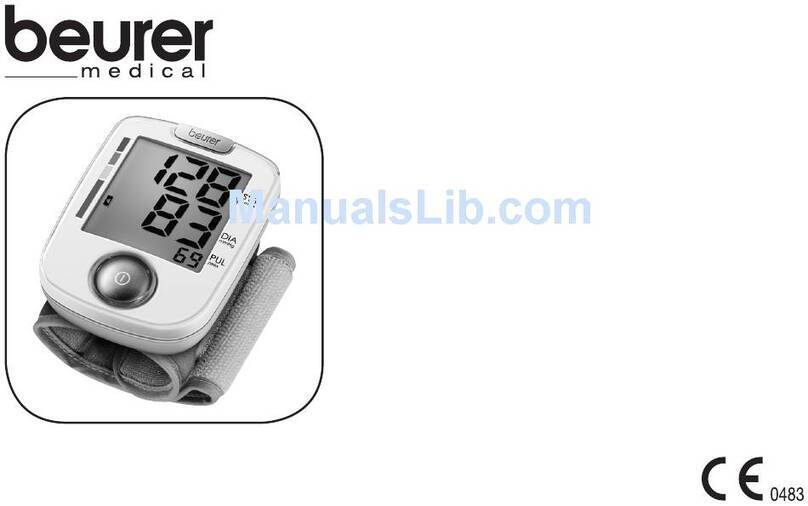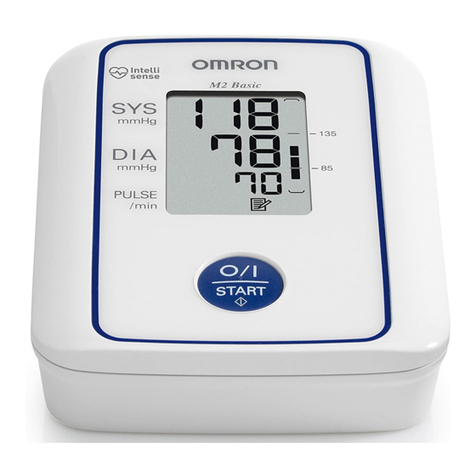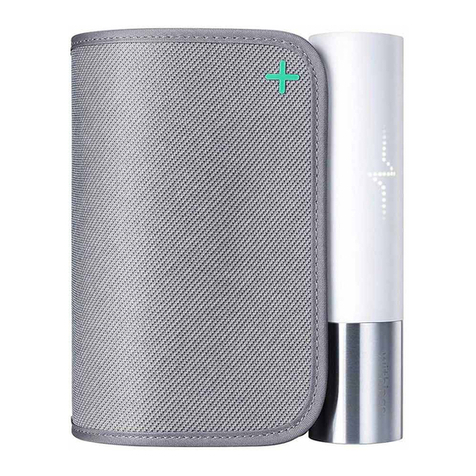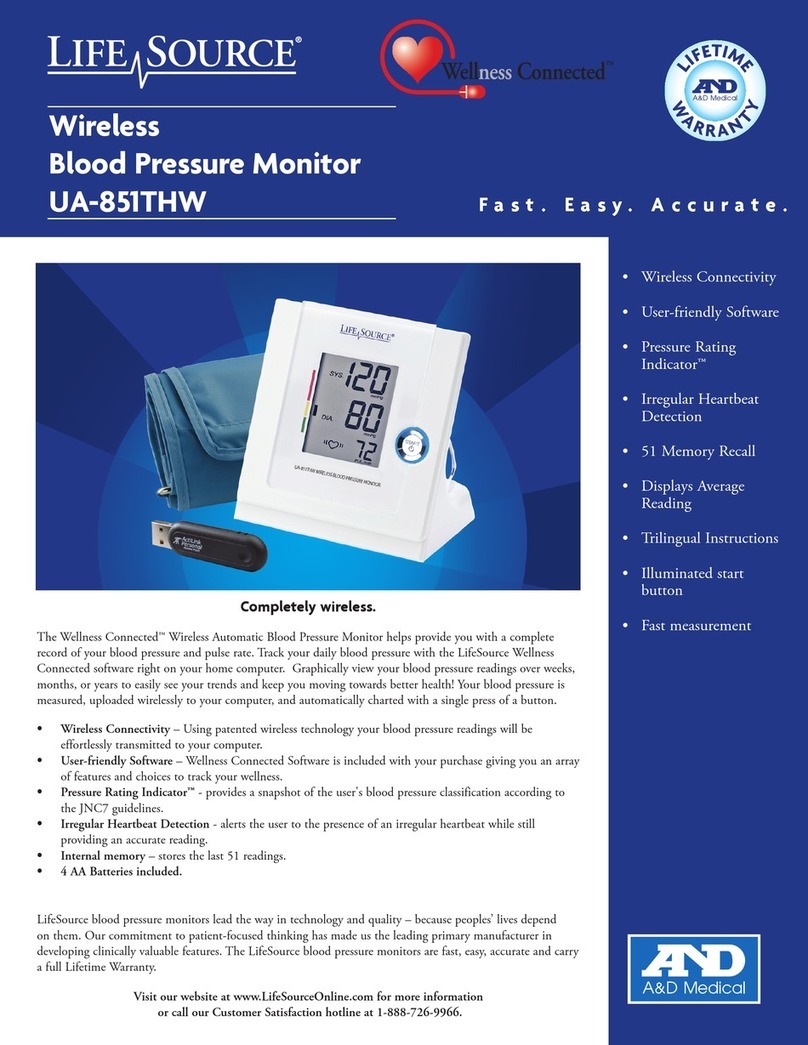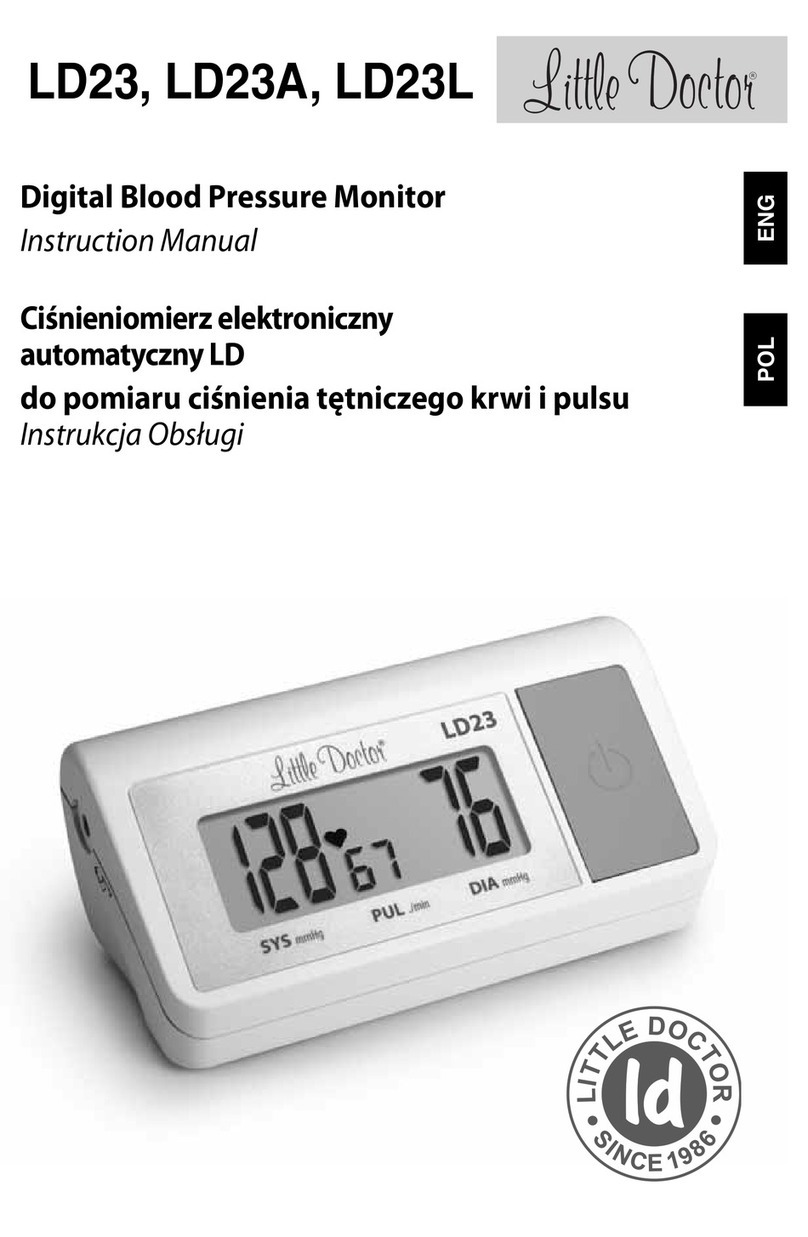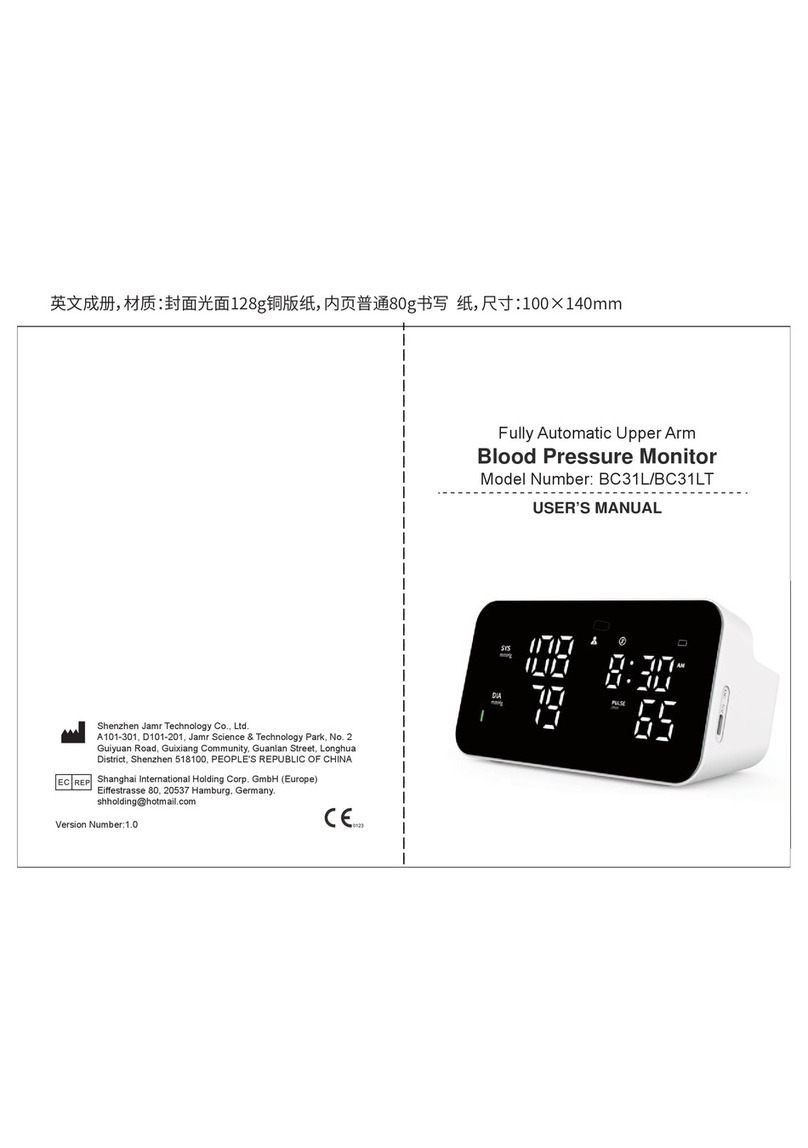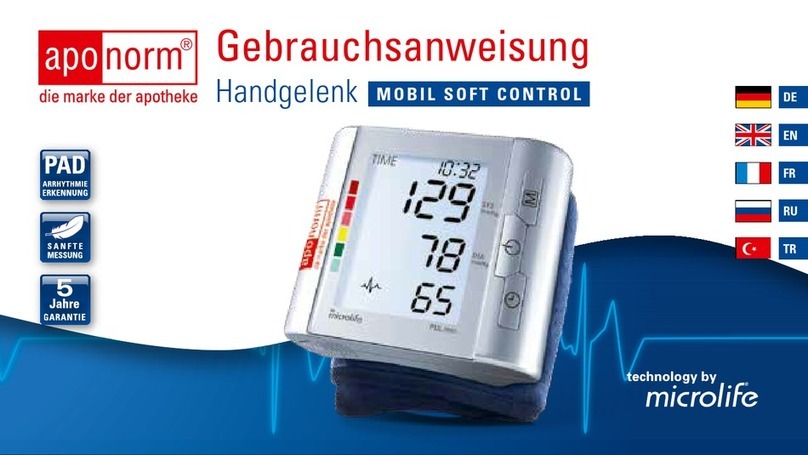Nissei DSK-1011J User manual

BLOOD PRESSURE MONITOR DSK-1011J
INSTRUCTIONS
This manual is intended to assist you in the safe and efficient operation of BLOOD PRESSURE MONITOR DSK-1011J. The product must be used in accordance with the procedures contained in this manual and must
not be used for purposes other than those described herein. It is important to read and understand the entire manual. In particular, please read carefully and become familiar with the section entitled “TIPS ON TAKING
YOUR BLOOD PRESSURE”.
CONTENTS
PART NAMES AND PRODUCT COMPONENTS. . . . . . . . . . . . . 1
GENERAL INFORMATION.........................1
PRECAUTIONS AND CONTRAINDICATIONS. . . . . . . . . . . . 2
TIPS ON TAKING YOUR BLOOD PRESSURE. . . . . . . . . . . . . 2
PREPARATION BEFORE USE. . . . . . . . . . . . . . . . . . . . . 2
MAKING A MEASUREMENT. . . . . . . . . . . . . . . . . . . . . . . . 3
VIEWING THE SAVED READINGS (MEMORY FUNCTION) . . . 4
TROUBLESHOOTING. . . . . . . . . . . . . . . . . . . . . . . . . . . 4
WARRANTY. . . . . . . . . . . . . . . . . . . . . . . . . . . . . . . . . 4
PART NAMES AND PRODUCT COMPONENTS
GENERAL INFORMATION
INDICATIONS FOR USE
This product is intended for noninvasive measurement of systolic and diastolic blood pressure,
determination of pulse rate and calculation of pulse pressure in adults in a home healthcare environment.
The product is not designed for neonatal use. Please consult with your doctor or physician to use this
product to take blood pressure of child or person in pregnancy or under pre-eclamptic condition.
WHO CLASSIFICATION SYMBOL
Measured blood pressure values
are classified against WHO
guideline (2009).
The higher class applies when
systolic and diastolic pressures fall
into different classes. For specific
information on your blood pressure,
contact your physician. Never make
any judgment on your own based
on the classification indication only.
PULSE PRESSURE DISPLAY
This product calculates and displays pulse pressure.
While systolic blood pressure keeps increasing with age, diastolic blood pressure tends to start
decreasing at around age 50. Pulse pressure is value subtracting diastolic value from systolic value and
therefore pulse pressure tends to increase with age. Pulse pressure has been considered to be related to
stiffness of artery and has been studied as one of circulatory risk factors. It is sometimes said that 45
mmHg of pulse pressure is normal value. Pulse pressure only does not represent arterial sclerosis.
However, observation of pulse pressure in long term will be important.
CARE AND MAINTENANCE
Keep the product clean. Inspect its cleanliness after use. To clean, use only a soft dry cloth. Do not use
gasoline, paint thinner, or other strong solvents. Since the cuff may absorb perspiration and other fluids, inspect
it for stain and discoloration after each use. When cleaning the cuff, use a synthetic detergent and gently rub
the surface. Air dry thoroughly. Make sure fluid never gets in AIR HOSE. Do not machine wash or scrub it.
When storing the product, do not place heavy objects on it. Do not fold or bend the cuff forcibly. To
disconnect the cuff from the main unit, do not pull AIR HOSE but hold AIR PLUG and unplug it. Do not
coil AIR HOSE too tightly. When the product has been stored at a temperature below the freezing point,
keep it for at least 1 hour in a warm place before using. Remove the batteries if the product is to be
stored for an extended period of time. Keep the batteries out of reach of children.
We suggest that you have your blood pressure monitor checked every 2 years. This operation may only
be performed by the manufacturer or by firms authorized by the manufacturer.
METHOD OF MEASUREMENT
This product employs the oscillometric method for measurement of blood pressure and pulse rate. The
cuff is connected to the main unit and wrapped around the arm. Circuits within the cuff sense the small
oscillations in pressure against the cuff produced by the expansion and contraction of the arteries in
the arm in response to each heart beat. The amplitude of each pressure waves is measured,
converted to millimeters of mercury, and displayed on the LCD as a digital value.
MEASUREMENT ON INFLATION
Initially the cuff is rapidly inflated to the prescribed value at the
beginning of a measurement, during which the inflation mark is
displayed. After the pressure reaches this point, the inflation mark
disappears and the cuff is inflated more gradually, during which
pulse wave is detected. As pulse wave is detected, heart mark
flashes with synchronizing beep. Measurement ends when systolic
blood pressure is determined and air is exhausted from the cuff.
PERSONAL MODE
The inflation is adjusted based on the latest three readings in the
selected bank, either [1] or [2], to shorten the measurement time
and to improve comfort.
For example, high diastolic blood pressure values from past three
measurements will lead to inflation to higher pressure value than
the default value. In the event that this value is too high for your
current blood pressure, the cuff will rapidly deflate and
measurement will restart.
To use the personal mode effectively, chose the memory bank before starting a measurement. This
monitor remembers the last memory bank that was displayed. To choose the memory bank before
starting a measurement, display a reading saved in the desired memory bank, turn off the monitor
once and then start measurement.
BODY MOTION SYMBOL
Blood pressure value taken while moving cannot be said to be the correct value because body
movement can affect blood pressure.
This product analyzes pulse wave and displays [
] when body motion is detected.
[
] indicates the results might be affected by body movement.
IRREGULAR PULSE RHYTHM SYMBOL
Pulse rhythm can be disturbed from talking, moving or
arrhythmias. This product displays [
]when the
difference of shortest and longest time intervals between
pulse waves is over 25%, indicating irregular pulse
rhythm.
MEMORY FUNCTION
The measured values are automatically saved for later review in either one of two memory banks, [1]
or [2]. These two memory banks can be used to save readings of two persons separately or to save
morning readings and evening readings separately.
Each bank can save up to 60 readings. When the number of stored readings reaches 60, the oldest
reading will be deleted to record new reading.
Saved readings are recalled with measurement date and time when clock function is activated. *The clock
needs to be activated before measurement for date and time to be saved with the measured valued.
[Err] results are not saved.
PRODUCT SPECIFICATIONS
Model : DSK-1011J
Operating Principle : Oscillometric method
Indicator : 15 digits liquid crystal display
Pressure Indicating Range : 3 to 300 mmHg (cuff pressure)
Measuring Range :
50 to 250 mmHg (systolic), 40 to 180 mmHg (diastolic), 40 to 160 bpm (pulse rate)
Accuracy* : ±3 mmHg (cuff pressure), ±5% of reading (pulse rate)
Inflation : Automatic inflation
Exhaust : Automatic exhaust valve
Power Supply : Four 1.5 volt LR6 (AA alkaline) batteries or AC adaptor ADP-W5 series
Protection against electric shock
: Internally powered equipment, Type BF applied part (cuff)
Mode of operation : Continuous operation
Classification : Internally powered equipment
Key to symbols : Type BF applied part
: Refer to instruction manual/booklet.
: Class II equipment
Specifications are subject to change without prior notice.
This product complies with JIST1115 (noninvasive electric blood pressure monitors) and EMC
(electromagnetic compatibility) Standard IEC60601-1-2:2007. (CISPR Classification: Group 1, Class B)
*Test procedure is based on ANSI/AAMI SP10:2002, American National Standard for electronic or
automated Sphygmomanometers, and Amendment.
-1-
AIR PLUG
AIR CONNECTOR
DISPLAY
“START/STOP” KEY
MEMORY KEY [2]MEMORY KEY [1]
“SET” KEY
BATTERY
COMPARTMENT
AC CONNECTOR
MAIN UNIT CUFF INSTRUCTIONS
AIR HOSE
PRESSURE
TIME
RAPID
INFLATION
GRADUAL
INFLATION RAPID
EXHAUST
PRESSURE
TIME
INITIAL PRESSURE
CHANGE
AN EXAMPLE OF PRESSURE
CHANGE DETERMINED WITH
"PERSONAL MODE"
SYS (mmHg)
>180
160-179
140-159
130-139
120-129
<120
DIA (mmHg)
>110
100-109
90-99
85-89
80-84
<80
WHO CLASSIFICATION
Grade 3 Hypertension
Grade 2 Hypertension
Grade 1 Hypertension
High Normal
Normal
Optimal
DISPLAY
WHO: World Health Organization
For test use
AA (LR6) BATTERIES
ATTACHED DOCUMENT
ENGLISH CHINESE
JAPANESE
A125095-1_3
regular pulse rhythm
An example of irregular pulse rhythm
compared to regular pulse rhythm
Power Consumption : 4W (max.)
Electric Rating : DC6V/4W, with four LR6 batteries
Adaptor; AC100-240V, 50-60Hz, 0.12A,
Unit; DC6V, 500mA, with designated AC adaptor
Memory : 2 banks, each stores 60 readings
Operating Condition : +10˚C to +40˚C, 30% to 85% RH (noncondensing)
Transportation/Storage Condition
: -20˚C to +60˚C, 10% to 95% RH (noncondensing)
Cuff : Coverage arm circumference; 22 to 32 cm, applied part; BF
Main Unit : Weight; Approx. 250 g (without batteries)
Size; Approx. 115 x 115 x 65.9 mm (W x D x H)
Protection against harmful ingress of water
: IPX0

INDICATIONS FOR USE
This product is intended for noninvasive measurement of systolic and diastolic blood pressure,
determination of pulse rate and calculation of pulse pressure in adults in a home healthcare environment.
The product is not designed for neonatal use. Please consult with your doctor or physician to use this
product to take blood pressure of child or person in pregnancy or under pre-eclamptic condition.
WHO CLASSIFICATION SYMBOL
Measured blood pressure values
are classified against WHO
guideline (2009).
The higher class applies when
systolic and diastolic pressures fall
into different classes. For specific
information on your blood pressure,
contact your physician. Never make
any judgment on your own based
on the classification indication only.
PULSE PRESSURE DISPLAY
This product calculates and displays pulse pressure.
While systolic blood pressure keeps increasing with age, diastolic blood pressure tends to start
decreasing at around age 50. Pulse pressure is value subtracting diastolic value from systolic value and
therefore pulse pressure tends to increase with age. Pulse pressure has been considered to be related to
stiffness of artery and has been studied as one of circulatory risk factors. It is sometimes said that 45
mmHg of pulse pressure is normal value. Pulse pressure only does not represent arterial sclerosis.
However, observation of pulse pressure in long term will be important.
CARE AND MAINTENANCE
Keep the product clean. Inspect its cleanliness after use. To clean, use only a soft dry cloth. Do not use
gasoline, paint thinner, or other strong solvents. Since the cuff may absorb perspiration and other fluids, inspect
it for stain and discoloration after each use. When cleaning the cuff, use a synthetic detergent and gently rub
the surface. Air dry thoroughly. Make sure fluid never gets in AIR HOSE. Do not machine wash or scrub it.
When storing the product, do not place heavy objects on it. Do not fold or bend the cuff forcibly. To
disconnect the cuff from the main unit, do not pull AIR HOSE but hold AIR PLUG and unplug it. Do not
coil AIR HOSE too tightly. When the product has been stored at a temperature below the freezing point,
keep it for at least 1 hour in a warm place before using. Remove the batteries if the product is to be
stored for an extended period of time. Keep the batteries out of reach of children.
We suggest that you have your blood pressure monitor checked every 2 years. This operation may only
be performed by the manufacturer or by firms authorized by the manufacturer.
METHOD OF MEASUREMENT
This product employs the oscillometric method for measurement of blood pressure and pulse rate. The
cuff is connected to the main unit and wrapped around the arm. Circuits within the cuff sense the small
oscillations in pressure against the cuff produced by the expansion and contraction of the arteries in
the arm in response to each heart beat. The amplitude of each pressure waves is measured,
converted to millimeters of mercury, and displayed on the LCD as a digital value.
MEASUREMENT ON INFLATION
Initially the cuff is rapidly inflated to the prescribed value at the
beginning of a measurement, during which the inflation mark is
displayed. After the pressure reaches this point, the inflation mark
disappears and the cuff is inflated more gradually, during which
pulse wave is detected. As pulse wave is detected, heart mark
flashes with synchronizing beep. Measurement ends when systolic
blood pressure is determined and air is exhausted from the cuff.
PERSONAL MODE
The inflation is adjusted based on the latest three readings in the
selected bank, either [1] or [2], to shorten the measurement time
and to improve comfort.
For example, high diastolic blood pressure values from past three
measurements will lead to inflation to higher pressure value than
the default value. In the event that this value is too high for your
current blood pressure, the cuff will rapidly deflate and
measurement will restart.
To use the personal mode effectively, chose the memory bank before starting a measurement. This
monitor remembers the last memory bank that was displayed. To choose the memory bank before
starting a measurement, display a reading saved in the desired memory bank, turn off the monitor
once and then start measurement.
BODY MOTION SYMBOL
Blood pressure value taken while moving cannot be said to be the correct value because body
movement can affect blood pressure.
This product analyzes pulse wave and displays [
] when body motion is detected.
[
] indicates the results might be affected by body movement.
IRREGULAR PULSE RHYTHM SYMBOL
Pulse rhythm can be disturbed from talking, moving or
arrhythmias. This product displays [
]when the
difference of shortest and longest time intervals between
pulse waves is over 25%, indicating irregular pulse
rhythm.
MEMORY FUNCTION
The measured values are automatically saved for later review in either one of two memory banks, [1]
or [2]. These two memory banks can be used to save readings of two persons separately or to save
morning readings and evening readings separately.
Each bank can save up to 60 readings. When the number of stored readings reaches 60, the oldest
reading will be deleted to record new reading.
Saved readings are recalled with measurement date and time when clock function is activated. *The clock
needs to be activated before measurement for date and time to be saved with the measured valued.
[Err] results are not saved.
PRODUCT SPECIFICATIONS
Model : DSK-1011J
Operating Principle : Oscillometric method
Indicator : 15 digits liquid crystal display
Pressure Indicating Range : 3 to 300 mmHg (cuff pressure)
Measuring Range :
50 to 250 mmHg (systolic), 40 to 180 mmHg (diastolic), 40 to 160 bpm (pulse rate)
Accuracy* : ±3 mmHg (cuff pressure), ±5% of reading (pulse rate)
Inflation : Automatic inflation
Exhaust : Automatic exhaust valve
Power Supply : Four 1.5 volt LR6 (AA alkaline) batteries or AC adaptor ADP-W5 series
Protection against electric shock
: Internally powered equipment, Type BF applied part (cuff)
Mode of operation : Continuous operation
Classification : Internally powered equipment
Key to symbols : Type BF applied part
: Refer to instruction manual/booklet.
: Class II equipment
Specifications are subject to change without prior notice.
This product complies with JIST1115 (noninvasive electric blood pressure monitors) and EMC
(electromagnetic compatibility) Standard IEC60601-1-2:2007. (CISPR Classification: Group 1, Class B)
*Test procedure is based on ANSI/AAMI SP10:2002, American National Standard for electronic or
automated Sphygmomanometers, and Amendment.
PRECAUTIONS AND CONTRAINDICATIONS
PREPARATION BEFORE USE
-2-
Install batteries and activate the clock before use. Measurement can be made with clock being
inactivated. However, activate the clock to save measurement date and time with readings for better
review. The clock is inactivated as the batteries are removed. The product can be also operated with
AC adaptor. See page 3.
INSTALLING BATTERIES
Open the battery compartment cover, pressing the projection
between [
] and [
] at the bottom of the main unit.
1
Read this instruction manual carefully before use and use this product correctly. The instructions below
are to help you use the product correctly and to prevent you from being harmed or injured.
The subjects or use which exceeds the responsibility of the manufacturer such as the use beyond
the design limit or the unjustified use. (Ones with possible death or serious injury are indicated.)
General cautions for use of the product. (The subjects which may result in personal injury or
property damage in case the product is incorrectly handled are indicated.)
*Property damage means consequential damage for house, household belongings, livestock or pet.
Prohibition
• Do not use the product for infants or persons who cannot express their will. It may cause an
accident or an injury.
• Do not bring the product in the test room when having a MRI scan. It may cause the attraction
by magnetic force or the thermal burn.
• Do not use the product near flammable gas, such as anesthetic gas, or in locations or
atmospheres with high oxygen concentration such as hyperbaric oxygen chambers/therapy
devices or oxygen tents. It may cause malfunction, breakage, deterioration or inducement of
explosion.
• Do not make any diagnoses or treat yourself based on your own measurement results. Make
measurement based on the consultation with your doctor and receive professional treatment and
prescription.
• Do not use the product, if you have an injury on/around your arm. It may cause the
aggravation of the injury.
• Do not use the product during intravenous drip injections or blood transfusions. It may
cause an accident or an injury.
• Do not use the product with exceeding its service life. The service life of the product is either 5
years or 30,000 times.
• Do not use the product in the medical institution or public area where the product is
subject to be used by unspecified persons. It may cause an accident or a trouble.
Caution
Prohibition
Caution
• Do not use the product near mobile phones, micro ovens or other strong electromagnetic
devices. It may cause malfunctions or damage the product.
• Be cautious about using the product in conjunction with the medical electrical equipment
listed below. It may cause malfunctions.
· Pace makers, implantable defibrillators, or other wearable medical electrical equipment that is
easily affected by electromagnetic force
·
Wearable medical electrical equipment such as an electrocardiographic monitor.
• Consult a doctor when persons in pregnancy use the product.
• Do not use the product for purposes other than measuring blood pressure. It may damage
the product or cause an accident.
• Do not use the cuff around anywhere other than your upper arm. It may damage the product
or cause an accident.
• When using the monitor in an environment where systems connecting fluid with blood
vessels such as dialysis and intravenous drip injection are used, do not connect the blood
pressure monitor and the system. An accident may be caused if the air enters a blood vessel.
• Consult a doctor before using the product for persons suffering from arrhythmia or peripheral
circulatory disorders caused by diabetes, liver disease, arteriosclerosis or hypertension.
• When using the cuff, use the supplied equipment. Using equipment other than that supplied
may cause measurement error.
• Measure the circumference of your upper arm and make sure that it is within the suggested
range. Using the product for an arm outside the suggested range may cause measurement error.
• Do not place heavy items on the product or tie up the air hose. It may damage the product.
• Do not make an impact on or drop the product. It may cause malfunctions or damage the product.
• Wear the cuff correctly and keep it level with the heart during measurement. Wearing the cuff
incorrectly or at the wrong height may cause measurement error.
• Be cautious that blood pressure is affected by the factors below.
·
Time and season · Physical activity · Taking medicine for high blood pressure
·
Eating and drinking (including Alcohol) ·
Smoking · Mental nervousness ·
Bathing
·
The urge to urinate ·
Conversation · Other environment (during medical examination etc.)
·
Measurement posture (including the cuff level against the heart)
• Touch the “START/STOP” KEY if the product applies an excessive level of pressure to your
arm. Touching the “START/STOP” KEY releases the air from the cuff immediately, and the
product stops measuring.
• The cuff may leave bruises on your arm. If you feel any pain, touch the “START/STOP” KEY
to stop the operation of the product. Touching the “START/STOP” KEY releases the air from
the cuff immediately, and the product stops measuring.
• Do not plug/unplug the AC adaptor with wet hands, or touch it with tweezers, or other
electronically conductive devices.
• Do not touch another person while touching the batteries, battery terminals of the device or
the output plug of the AC adaptor, such as when replacing the batteries or
plugging/unplugging the AC adaptor.
• Do not use new batteries in conjunction with old batteries or different types of batteries at
the same time. It may generate heat and damage the product.
• Pull the plug out from the power outlet if anything unusual is detected during use. Plugging
the AC adaptor in a power outlet located behind furniture may be inconvenient if it needs to be
pulled out in an emergency.
• Do not unplug the AC adaptor by pulling the cable. It may damage the cable and cause a fire
or electric shock.
• Take the batteries out when not using the product for a long period of time. Battery fluid may
leak from the batteries and damage the product.
• Do not allow children to handle the product alone or leave the product in a place children
can reach. It may injure the children.
• Do not disassemble, repair or modify the product. It may cause malfunctions or damage the product.
• Check if the product is dirty or wet before use.
• If the product stops functioning properly, stop using it. Please contact us for repair or
assistance.
• Follow the local regulations of your area when disposing the product or batteries.
Power Consumption : 4W (max.)
Electric Rating : DC6V/4W, with four LR6 batteries
Adaptor; AC100-240V, 50-60Hz, 0.12A,
Unit; DC6V, 500mA, with designated AC adaptor
Memory : 2 banks, each stores 60 readings
Operating Condition : +10˚C to +40˚C, 30% to 85% RH (noncondensing)
Transportation/Storage Condition
: -20˚C to +60˚C, 10% to 95% RH (noncondensing)
Cuff : Coverage arm circumference; 22 to 32 cm, applied part; BF
Main Unit : Weight; Approx. 250 g (without batteries)
Size; Approx. 115 x 115 x 65.9 mm (W x D x H)
Protection against harmful ingress of water
: IPX0
TIPS ON TAKING YOUR BLOOD PRESSURE
Blood pressure is the force exerted by the heart in pumping the blood through the arteries and the
resistance by the veins in this flow.
Blood pressure varies all the time, influenced by mental and physical factors, and is never
constant.
In general, blood pressure is highest during the working hours and gradually decreases during the afternoon
and evening hours. It is low during sleep and increases at a relatively fast rate after arising from bed.
Causes for Changes in Blood Pressure
· Time and season · Physical activity · Taking medicine for high blood pressure
· Eating and drinking (including Alcohol) ·
Smoking · Mental nervousness ·
Bathing
· The urge to urinate ·
Conversation · Other environment (during medical examination etc.)
· Measurement posture (including the cuff level against the heart)
Let a qualified physician interpret your blood pressure readings.
Depending on your age, weight and general condition, blood pressure can be slightly different. Consult
with your doctor on determining what blood pressure is normal for you.
Blood pressure measured at home tends to be lower than when measured in a hospital,
clinic or doctor's office.
This is because you are tense at the hospital and relaxed at home. It is important to know your stable
normal blood pressure at home.
Before taking blood pressure, rest for approximately five minutes and take your blood pressure while
relaxed in a quiet environment.
Measure blood pressure using the correct posture and do not move or speak during measurement.
Avoid exercise, eating, drinking alcohol, smoking and other activities that affect your blood pressure
right before a measurement.
Take your blood pressure at the same time every day.
The ambient temperature should be approximately 20˚C when you take your blood pressure.
Reading may vary slightly, depending on posture, whether sitting or lying.

DEFLATION
SYMBOL
INFLATION
SYMBOL
PULSE SYMBOL
3TURN ON THE MONITOR.
Touch “START/STOP” KEY.
Air is exhausted from the cuff.
Automatic inflation starts.
Inflation symbol disappears and inflation becomes slow.
PULSE SYMBOL is displayed as pulse is detected.
Air is released from the cuff and measured values are
displayed as measurement completes.
Touch “START/STOP” KEY again to cancel
measurement.
The monitor will exhaust air from the cuff and turn
off.
4SELECT MEMORY BANK TO SAVE THE MEASUREMENT RESULT.
MEMORY SYMBOL is displayed below MEMORY KEY.
Touching MEMORY KEY will switch the bank.
MEMORY MARK
Readings are automatically saved in the bank, either MEMORY [1] or [2], selected when the monitor
is turned off after measurement. Make sure to confirm the bank selected after a measurement.
Refer to page 1 for memory function.
INDICATIONS FOR USE
This product is intended for noninvasive measurement of systolic and diastolic blood pressure,
determination of pulse rate and calculation of pulse pressure in adults in a home healthcare environment.
The product is not designed for neonatal use. Please consult with your doctor or physician to use this
product to take blood pressure of child or person in pregnancy or under pre-eclamptic condition.
WHO CLASSIFICATION SYMBOL
Measured blood pressure values
are classified against WHO
guideline (2009).
The higher class applies when
systolic and diastolic pressures fall
into different classes. For specific
information on your blood pressure,
contact your physician. Never make
any judgment on your own based
on the classification indication only.
PULSE PRESSURE DISPLAY
This product calculates and displays pulse pressure.
While systolic blood pressure keeps increasing with age, diastolic blood pressure tends to start
decreasing at around age 50. Pulse pressure is value subtracting diastolic value from systolic value and
therefore pulse pressure tends to increase with age. Pulse pressure has been considered to be related to
stiffness of artery and has been studied as one of circulatory risk factors. It is sometimes said that 45
mmHg of pulse pressure is normal value. Pulse pressure only does not represent arterial sclerosis.
However, observation of pulse pressure in long term will be important.
CARE AND MAINTENANCE
Keep the product clean. Inspect its cleanliness after use. To clean, use only a soft dry cloth. Do not use
gasoline, paint thinner, or other strong solvents. Since the cuff may absorb perspiration and other fluids, inspect
it for stain and discoloration after each use. When cleaning the cuff, use a synthetic detergent and gently rub
the surface. Air dry thoroughly. Make sure fluid never gets in AIR HOSE. Do not machine wash or scrub it.
When storing the product, do not place heavy objects on it. Do not fold or bend the cuff forcibly. To
disconnect the cuff from the main unit, do not pull AIR HOSE but hold AIR PLUG and unplug it. Do not
coil AIR HOSE too tightly. When the product has been stored at a temperature below the freezing point,
keep it for at least 1 hour in a warm place before using. Remove the batteries if the product is to be
stored for an extended period of time. Keep the batteries out of reach of children.
We suggest that you have your blood pressure monitor checked every 2 years. This operation may only
be performed by the manufacturer or by firms authorized by the manufacturer.
METHOD OF MEASUREMENT
This product employs the oscillometric method for measurement of blood pressure and pulse rate. The
cuff is connected to the main unit and wrapped around the arm. Circuits within the cuff sense the small
oscillations in pressure against the cuff produced by the expansion and contraction of the arteries in
the arm in response to each heart beat. The amplitude of each pressure waves is measured,
converted to millimeters of mercury, and displayed on the LCD as a digital value.
MEASUREMENT ON INFLATION
Initially the cuff is rapidly inflated to the prescribed value at the
beginning of a measurement, during which the inflation mark is
displayed. After the pressure reaches this point, the inflation mark
disappears and the cuff is inflated more gradually, during which
pulse wave is detected. As pulse wave is detected, heart mark
flashes with synchronizing beep. Measurement ends when systolic
blood pressure is determined and air is exhausted from the cuff.
PERSONAL MODE
The inflation is adjusted based on the latest three readings in the
selected bank, either [1] or [2], to shorten the measurement time
and to improve comfort.
For example, high diastolic blood pressure values from past three
measurements will lead to inflation to higher pressure value than
the default value. In the event that this value is too high for your
current blood pressure, the cuff will rapidly deflate and
measurement will restart.
To use the personal mode effectively, chose the memory bank before starting a measurement. This
monitor remembers the last memory bank that was displayed. To choose the memory bank before
starting a measurement, display a reading saved in the desired memory bank, turn off the monitor
once and then start measurement.
BODY MOTION SYMBOL
Blood pressure value taken while moving cannot be said to be the correct value because body
movement can affect blood pressure.
This product analyzes pulse wave and displays [
] when body motion is detected.
[
] indicates the results might be affected by body movement.
IRREGULAR PULSE RHYTHM SYMBOL
Pulse rhythm can be disturbed from talking, moving or
arrhythmias. This product displays [
]when the
difference of shortest and longest time intervals between
pulse waves is over 25%, indicating irregular pulse
rhythm.
MEMORY FUNCTION
The measured values are automatically saved for later review in either one of two memory banks, [1]
or [2]. These two memory banks can be used to save readings of two persons separately or to save
morning readings and evening readings separately.
Each bank can save up to 60 readings. When the number of stored readings reaches 60, the oldest
reading will be deleted to record new reading.
Saved readings are recalled with measurement date and time when clock function is activated. *The clock
needs to be activated before measurement for date and time to be saved with the measured valued.
[Err] results are not saved.
PRODUCT SPECIFICATIONS
Model : DSK-1011J
Operating Principle : Oscillometric method
Indicator : 15 digits liquid crystal display
Pressure Indicating Range : 3 to 300 mmHg (cuff pressure)
Measuring Range :
50 to 250 mmHg (systolic), 40 to 180 mmHg (diastolic), 40 to 160 bpm (pulse rate)
Accuracy* : ±3 mmHg (cuff pressure), ±5% of reading (pulse rate)
Inflation : Automatic inflation
Exhaust : Automatic exhaust valve
Power Supply : Four 1.5 volt LR6 (AA alkaline) batteries or AC adaptor ADP-W5 series
Protection against electric shock
: Internally powered equipment, Type BF applied part (cuff)
Mode of operation : Continuous operation
Classification : Internally powered equipment
Key to symbols : Type BF applied part
: Refer to instruction manual/booklet.
: Class II equipment
Specifications are subject to change without prior notice.
This product complies with JIST1115 (noninvasive electric blood pressure monitors) and EMC
(electromagnetic compatibility) Standard IEC60601-1-2:2007. (CISPR Classification: Group 1, Class B)
*Test procedure is based on ANSI/AAMI SP10:2002, American National Standard for electronic or
automated Sphygmomanometers, and Amendment.
Keep your finger
on the key.
ADJUST DATE AND TIME AND ACTIVATE THE CLOCK
The flashing number increases with MEMORY KEY [1] and decreases with
KEY [2]. The number will be fast-forwarded if you keep your finger on the key.
Touching “SET” key will fix the number and the next article will flash. Touching
“START/STOP” key will terminate the setting.
As the date and time are set, clock is activated.
Display of the clock while the device is turned off indicates that the clock is activated.
decreaseincrease
confirm
2
MAKING A MEASUREMENT
TIME
SYSTOLIC
DIASTO LIC
WHO CLASSI FICATI ON
SYMBOL
PULSE PRESSURE
PULSE RATE
MEMORY MARK
Refer to page 1 for [
].
Refer to page 1 for [
].
Refer to page 4 for “Err” display.
Do not execute repeated measurements for congestion of blood could result in false
measurement. Let your arm rest for at least 5 minutes.
TURN OFF THE MONITOR.
Touch “START/STOP” KEY.
The monitor will be turned off. Even if you do not turn off the monitor, it turns off automatically after 3
minutes.
5
-3-
Insert AIR PLUG into AIR CONNECTOR before starting a blood
pressure measurement.
The cuff is applicable to arm with circumference between 22 and 32
cm. Take your arm size before measurement.
Choose your memory bank before measurement to use the
personal mode effectively.
Inaccurate readings may result if cuff is
wrapped over heavy clothing or tight shirt that
may restrict circulation in your upper arm or if
sleeve is rolled up.
AIR
CONNECTOR
OPERATION WITH AC ADAPTOR
AC CONNECTOR is located at the side of the monitor.
Use the designated AC adaptor only.
It is suggested to take out the batteries when using the adapter. However, the clock is inactivated as the
AC adaptor is unplugged and therefore you may insert the batteries to keep the clock activated. In such
case, please make a few measurement without plugging the adaptor to avoid battery leak.
Do not connect the AC adaptor to any power socket where accessibility is not satisfying.
AC CONNECTOR
Protection: This device is double insulated and protected against short circuit and overload by a
primary thermal fuse.
Enclosures and Protective Covers: Equipment enclosed to protect against contact with live parts,
and with parts which can become live (finger, pin, hook test).
SIT ON A CHAIR AND APPLY CUFF.
Find a chair and a table so that you can be comfortably seated with your feet flat on the floor and your
back and arm supported.
Put the cuff on your left arm with AIR HOSE
positioned toward your hand.
1
hook and loop
fastener
2 to 3 cm
Adjust the position of the cuff so that AIR HOSE is over the
inner part of your arm over the brachial artery.
Press the surface of the cuff to make sure that the hook &
loop fastens securely.
Attach the cuff with hook and loop fastener with
the lower edge of the cuff approximately 2 to 3 cm
above the inner elbow.
The cuff should fit snugly, leaving enough space for two fingers to be put between
your arm and the cuff.
If the cuff is wrapped more tightly or loosely
than this, inaccurate blood pressure
readings may result.
ELBOW
Let your forearm rest naturally on the table and keep the cuff at the height of
your heart during measurement.
If the cuff is lower (higher) than the heart, the measured reading tends to become higher
(lower).
2
SDG!DFG
SGLKSJPREJ
DKLFJGS
OGJOIER;J
Take deep breaths and relax.
Do not move or speak while taking your blood pressure.
Do not cross your legs during measurement.
Do not hold your breath.
AIR HOSEAIR HOSE
ARTERY
ARTERY
AA (LR6)
BATTERIES
Install four “AA” type batteries into the compartment.
Make sure that the polarities correspond to the (+) and (–)
marks inside the battery compartment.
Batteries can be easily installed or removed as their (-) ends
are pushed against the spring.
You will hear a beep as the batteries are installed.
NOTE: The beep will not sound if AC adaptor is connected.
Battery symbol [
] will flash when battery power is low. Measurement can not be made while the
symbol is displayed. Replace the batteries. All four batteries need to be replaced with new ones; do
not mix new and old batteries or different batteries.
The symbol might appear only during measurement although you can review readings in memory. This is
because more battery power is required for conducting a measurement, e.g. inflating the cuff, than
displaying the readings in memory. Please have the batteries replaced.
The enclosed batteries are for monitoring, and their life may be shorter than that of commercial batteries.
Close the battery compartment cover. Do not force the battery cover into position.
Insert two tabs to the main unit first, Fig.1). Then close the cover, pressing [
] section Fig.2). Close
the cover completely Fig.3).
PRESS
2)
click!
3)1)
two tabs
Power Consumption : 4W (max.)
Electric Rating : DC6V/4W, with four LR6 batteries
Adaptor; AC100-240V, 50-60Hz, 0.12A,
Unit; DC6V, 500mA, with designated AC adaptor
Memory : 2 banks, each stores 60 readings
Operating Condition : +10˚C to +40˚C, 30% to 85% RH (noncondensing)
Transportation/Storage Condition
: -20˚C to +60˚C, 10% to 95% RH (noncondensing)
Cuff : Coverage arm circumference; 22 to 32 cm, applied part; BF
Main Unit : Weight; Approx. 250 g (without batteries)
Size; Approx. 115 x 115 x 65.9 mm (W x D x H)
Protection against harmful ingress of water
: IPX0
Touch “SET” KEY and keep your
finger on the key until “20 11”
starts flashing.
Clock is set in the order of year,
month, day, hour and minute.

DELETING SAVED READINGS
DISPLAY THE READING TO DELETE.
Display the average reading to delete entire readings in the memory.
TOUCH MEMORY KEY AND KEEP YOUR FINGER TOUCHED TO THE KEY.
Touch MEMORY KEY [1] to delete reading in the memory bank [1] or MEMORY KEY [2] to delete
reading in the bank [2].
The display will start flashing. Keep your finger on the key until the reading is replaced with “
”.
??? Nothing is displayed.
Batteries are depleted.
Replace all batteries with new ones.
Batteries are inserted incorrectly.
Reinsert the batteries correctly.
Battery terminals are not clean.
Clean the terminals with dry cloth.
AC adaptor is not connected.
Connect AC adaptor.
Touching the keys with tip of finger or nail is touching the key.
Touch the key with the
plane of your finger.
??? Clock is not displayed.
The clock is inactivated. NOTE: Clock is inactivated when batteries and/or AC adaptor
are/is removed.
Adjust date and time and activate the clock.
??? Measurement date and time are displayed with “
” and “
”.
The clock is not activated.
Adjust date and time and activate the clock.
Measurement was taken before the clock was activated.
Measurement date and time
cannot be saved without clock being activated.
[Err-2] is displayed.
The cuff is not securely connected to the monitor.
Secure the air connector.
The cuff is
not wrapped appropriately.
Reconfirm how to put the cuff on your arm.
is displayed.
Batteries are weak. Replace all batteries with new ones.
If you cannot get correct measurement with the methods above, contact your dealer.
Do not disassemble or tamper with the internal mechanism.
1
3
1
2
2
Turn off the monitor once with “START/STOP” KEY when the results are displayed after a
measurement.
Refer to page 1 for memory function.
TOUCH MEMORY KEY.
Touch MEMORY KEY [1] to review readings saved in the memory bank [1] and MEMORY
KEY [2] to review those in the bank [2].
The average of the saved readings are displayed.
Note: Average will not be displayed unless there are two or
more readings saved.
NUMBER OF
SAVED RESULTS
: Average
TOUCH THE SAME MEMORY KEY AGAIN.
The latest reading saved in the selected bank is displayed.
The display at the top shows memory number,
measurement date and time alternately. The latest reading
is displayed as memory “No. 1”.
The results are recalled from the latest to the oldest with
operation of MEMORY KEY.
The bigger memory number indicates the older number.
SWITCHING MEMORY BANKS
Touching MEMORY KEY [2] at display of reading in the bank [1] will switch the display to reading
in bank [2] and touching MEMORY KEY [1] again will return to the display of result in the bank [1].
TURN OFF THE MONITOR.
Touch “START/STOP” KEY..
Even if you do not turn off the monitor, it displays the result for approximately 30 seconds and will turn
off automatically.
This equipment is guaranteed for the period of 1 year after the date of purchase against manufacturing defects when returned along with the proof of date of purchase to the dealer from whom the purchase was made. During this period, the unit will be
repaired or replaced free of charge if the failure is attributable to faulty design or manufacture. This warranty does not cover damage or malfunctions caused by improper handling or use contrary to the instructions in this manual. Please contact your
dealer for additional warranty provisions which may remain effective after the manufacturer's warranty period has expired.
INDICATIONS FOR USE
This product is intended for noninvasive measurement of systolic and diastolic blood pressure,
determination of pulse rate and calculation of pulse pressure in adults in a home healthcare environment.
The product is not designed for neonatal use. Please consult with your doctor or physician to use this
product to take blood pressure of child or person in pregnancy or under pre-eclamptic condition.
WHO CLASSIFICATION SYMBOL
Measured blood pressure values
are classified against WHO
guideline (2009).
The higher class applies when
systolic and diastolic pressures fall
into different classes. For specific
information on your blood pressure,
contact your physician. Never make
any judgment on your own based
on the classification indication only.
PULSE PRESSURE DISPLAY
This product calculates and displays pulse pressure.
While systolic blood pressure keeps increasing with age, diastolic blood pressure tends to start
decreasing at around age 50. Pulse pressure is value subtracting diastolic value from systolic value and
therefore pulse pressure tends to increase with age. Pulse pressure has been considered to be related to
stiffness of artery and has been studied as one of circulatory risk factors. It is sometimes said that 45
mmHg of pulse pressure is normal value. Pulse pressure only does not represent arterial sclerosis.
However, observation of pulse pressure in long term will be important.
CARE AND MAINTENANCE
Keep the product clean. Inspect its cleanliness after use. To clean, use only a soft dry cloth. Do not use
gasoline, paint thinner, or other strong solvents. Since the cuff may absorb perspiration and other fluids, inspect
it for stain and discoloration after each use. When cleaning the cuff, use a synthetic detergent and gently rub
the surface. Air dry thoroughly. Make sure fluid never gets in AIR HOSE. Do not machine wash or scrub it.
When storing the product, do not place heavy objects on it. Do not fold or bend the cuff forcibly. To
disconnect the cuff from the main unit, do not pull AIR HOSE but hold AIR PLUG and unplug it. Do not
coil AIR HOSE too tightly. When the product has been stored at a temperature below the freezing point,
keep it for at least 1 hour in a warm place before using. Remove the batteries if the product is to be
stored for an extended period of time. Keep the batteries out of reach of children.
We suggest that you have your blood pressure monitor checked every 2 years. This operation may only
be performed by the manufacturer or by firms authorized by the manufacturer.
METHOD OF MEASUREMENT
This product employs the oscillometric method for measurement of blood pressure and pulse rate. The
cuff is connected to the main unit and wrapped around the arm. Circuits within the cuff sense the small
oscillations in pressure against the cuff produced by the expansion and contraction of the arteries in
the arm in response to each heart beat. The amplitude of each pressure waves is measured,
converted to millimeters of mercury, and displayed on the LCD as a digital value.
MEASUREMENT ON INFLATION
Initially the cuff is rapidly inflated to the prescribed value at the
beginning of a measurement, during which the inflation mark is
displayed. After the pressure reaches this point, the inflation mark
disappears and the cuff is inflated more gradually, during which
pulse wave is detected. As pulse wave is detected, heart mark
flashes with synchronizing beep. Measurement ends when systolic
blood pressure is determined and air is exhausted from the cuff.
PERSONAL MODE
The inflation is adjusted based on the latest three readings in the
selected bank, either [1] or [2], to shorten the measurement time
and to improve comfort.
For example, high diastolic blood pressure values from past three
measurements will lead to inflation to higher pressure value than
the default value. In the event that this value is too high for your
current blood pressure, the cuff will rapidly deflate and
measurement will restart.
To use the personal mode effectively, chose the memory bank before starting a measurement. This
monitor remembers the last memory bank that was displayed. To choose the memory bank before
starting a measurement, display a reading saved in the desired memory bank, turn off the monitor
once and then start measurement.
BODY MOTION SYMBOL
Blood pressure value taken while moving cannot be said to be the correct value because body
movement can affect blood pressure.
This product analyzes pulse wave and displays [
] when body motion is detected.
[
] indicates the results might be affected by body movement.
IRREGULAR PULSE RHYTHM SYMBOL
Pulse rhythm can be disturbed from talking, moving or
arrhythmias. This product displays [
]when the
difference of shortest and longest time intervals between
pulse waves is over 25%, indicating irregular pulse
rhythm.
MEMORY FUNCTION
The measured values are automatically saved for later review in either one of two memory banks, [1]
or [2]. These two memory banks can be used to save readings of two persons separately or to save
morning readings and evening readings separately.
Each bank can save up to 60 readings. When the number of stored readings reaches 60, the oldest
reading will be deleted to record new reading.
Saved readings are recalled with measurement date and time when clock function is activated. *The clock
needs to be activated before measurement for date and time to be saved with the measured valued.
[Err] results are not saved.
PRODUCT SPECIFICATIONS
Model : DSK-1011J
Operating Principle : Oscillometric method
Indicator : 15 digits liquid crystal display
Pressure Indicating Range : 3 to 300 mmHg (cuff pressure)
Measuring Range :
50 to 250 mmHg (systolic), 40 to 180 mmHg (diastolic), 40 to 160 bpm (pulse rate)
Accuracy* : ±3 mmHg (cuff pressure), ±5% of reading (pulse rate)
Inflation : Automatic inflation
Exhaust : Automatic exhaust valve
Power Supply : Four 1.5 volt LR6 (AA alkaline) batteries or AC adaptor ADP-W5 series
Protection against electric shock
: Internally powered equipment, Type BF applied part (cuff)
Mode of operation : Continuous operation
Classification : Internally powered equipment
Key to symbols : Type BF applied part
: Refer to instruction manual/booklet.
: Class II equipment
Specifications are subject to change without prior notice.
This product complies with JIST1115 (noninvasive electric blood pressure monitors) and EMC
(electromagnetic compatibility) Standard IEC60601-1-2:2007. (CISPR Classification: Group 1, Class B)
*Test procedure is based on ANSI/AAMI SP10:2002, American National Standard for electronic or
automated Sphygmomanometers, and Amendment.
VIEWING THE SAVED READINGS (MEMORY FUNCTION)
TROUBLESHOOTING
WARRANTY
???
???
Blood pressure is extremely high or low.
The monitor is not adjusted to your heart.
Adjust the monitor to the height of your
heart.
Measurement is not taken with correct posture or the cuff is wrapped incorrectly.
Reconfirm the measurement procedures.
The reading was effected from moving or talking.
Remain still and quiet during
measurement.
Measurement was taken right after exercise or other activities influencing the reading.
Measure again after resting for more than 5 minutes. See TIPS ON TAKING
YOUR BLOOD PRESSURE.
??? Measured value is different from that taken at a hospital.
Mental condition such as nervousness at a hospital or relaxed feeling at home is
influencing blood pressure.
Take records of blood pressure taken at home and
consult with your doctor.
??? Inflation is repeated.
The cuff is inflated again if sudden change of pressure, which could be due to movement or
straining of arm or wrist, was detected. Inflation is repeated until blood pressure is taken.
Repeated inflation is not a malfunction of the monitor. Do not move or speak
during measurement.
Measured values vary all the time.
Mental and physical condition or measurement condition is influencing blood pressure.
Make measurement under the same condition.
Blood pressure is changing 24 hours a day in relation with mental and physical conditions. Eating,
drinking, smoking, exercising or bathing will alter blood pressure. Blood pressure will be also
influenced by mental condition such as feeling tensed or relieved and health condition It is
important to know the tendency of blood pressure by making measurement regularly. Make your
own rules including conditions and time to make measurement and take blood pressure everyday.
[Err-300] is displayed.
Over pressure: blood pressure could not be taken due to moving or speaking although the
cuff was inflated to the maximum pressure.
Do not move or speak during
measurement.
[Err-1] is displayed.
Blood pressure could not be taken due to moving or speaking.
Do not move or speak
during measurement.
[0 0] is displayed.
“START/STOP” KEY was being touched when batteries are being installed or when AC
adaptor is being plugged in.
Turn off the monitor once with “START/STOP” KEY.
Manufacturer :
NIHON SEIMITSU SOKKI CO., LTD.
2508-13 Nakago Shibukawa Gunma 377-0293 Japan
web site http://www.nissei-kk.co.jp/english/
-4-
Cuff end is loosened.
Put the cuff with its hook and loop
fastener side down. Put the cuff
end through the metal ring. Fold
back the cuff at the metal ring.
hook and loop fastener
metal ring
[ ] symbol is displayed again in the course of inflation and deflation and inflation of the
cuff are repeated.
When the initial pressure was too high for blood pressure to be taken or if you move or
strain your arm or hand, the cuff is inflated again. Deflation and inflation of the cuff are
repeated until blood pressure is taken. This does not indicate any problem or malfunction of
the monitor. Do not move or speak during measurement.
Power Consumption : 4W (max.)
Electric Rating : DC6V/4W, with four LR6 batteries
Adaptor; AC100-240V, 50-60Hz, 0.12A,
Unit; DC6V, 500mA, with designated AC adaptor
Memory : 2 banks, each stores 60 readings
Operating Condition : +10˚C to +40˚C, 30% to 85% RH (noncondensing)
Transportation/Storage Condition
: -20˚C to +60˚C, 10% to 95% RH (noncondensing)
Cuff : Coverage arm circumference; 22 to 32 cm, applied part; BF
Main Unit : Weight; Approx. 250 g (without batteries)
Size; Approx. 115 x 115 x 65.9 mm (W x D x H)
Protection against harmful ingress of water
: IPX0
Other Nissei Blood Pressure Monitor manuals

Nissei
Nissei DS-10 User manual
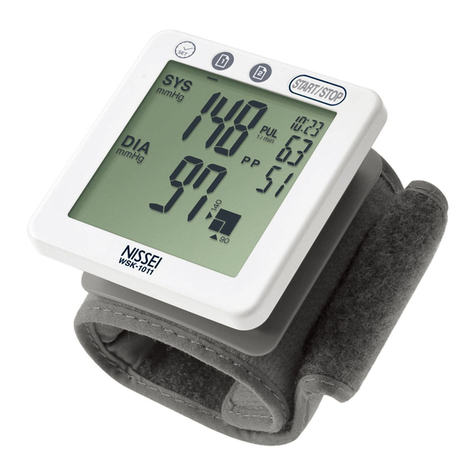
Nissei
Nissei WSK-1011 User manual

Nissei
Nissei WSK-1011 User manual
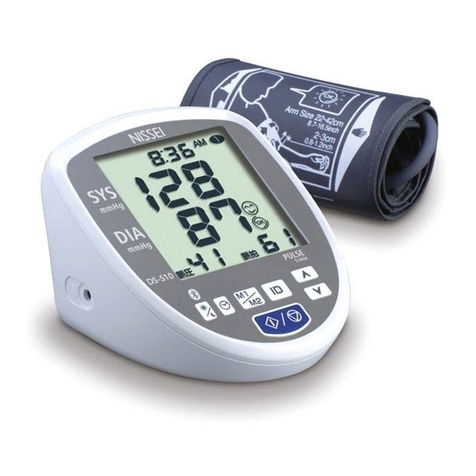
Nissei
Nissei DS-S10 User manual

Nissei
Nissei DSK-1031 User manual
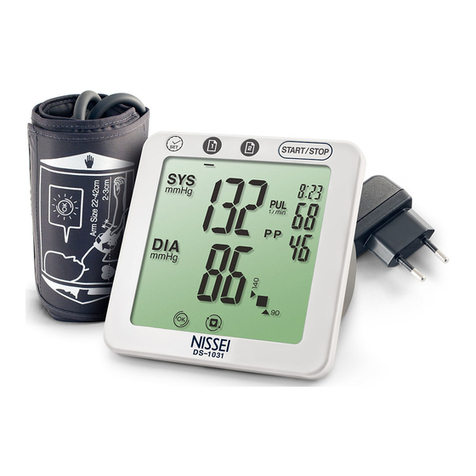
Nissei
Nissei DSK-1031 User manual

Nissei
Nissei DS-137 User manual
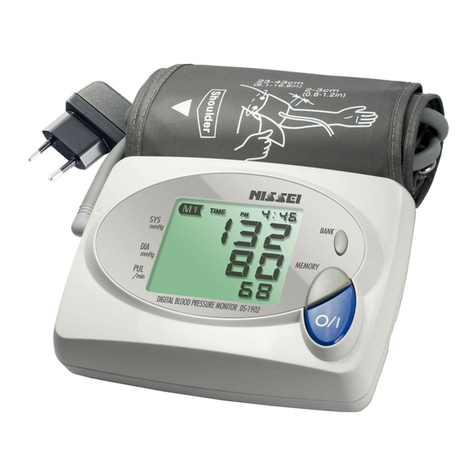
Nissei
Nissei ds-1902 User manual
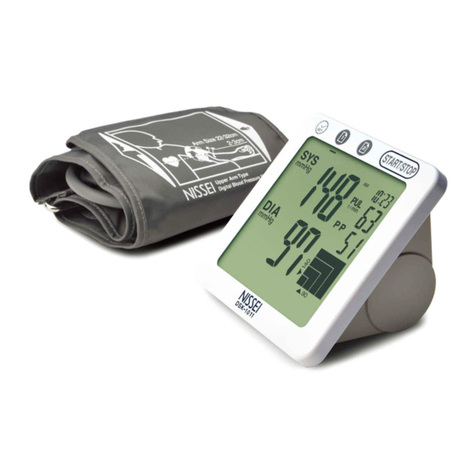
Nissei
Nissei DSK-1011 User manual
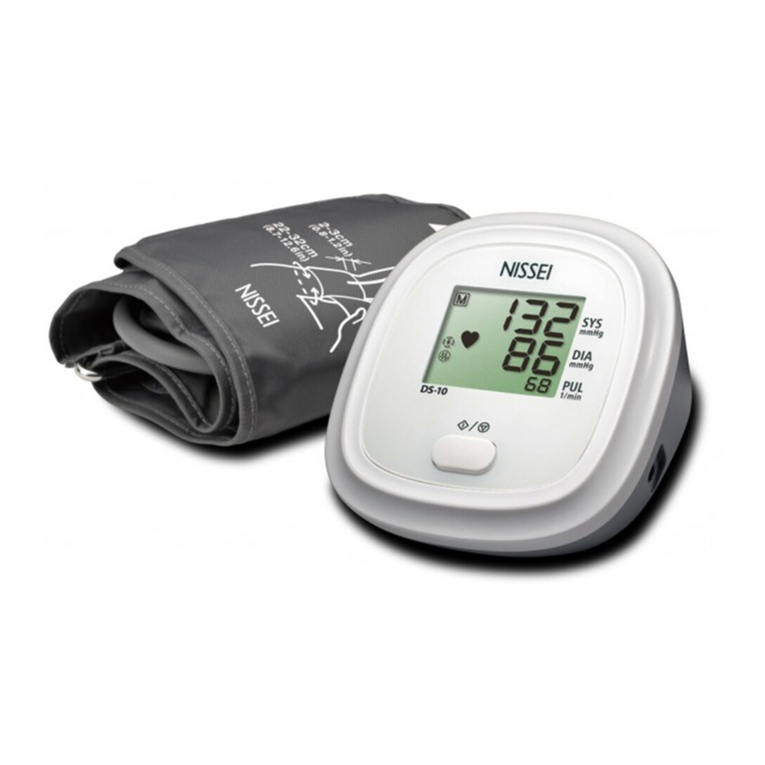
Nissei
Nissei DS-10 User manual
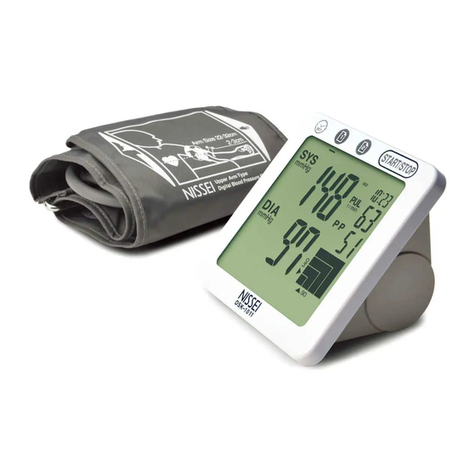
Nissei
Nissei DS-1011 User manual

Nissei
Nissei WS-1011 User manual

Nissei
Nissei WS-820 User manual

Nissei
Nissei DS-400 User manual
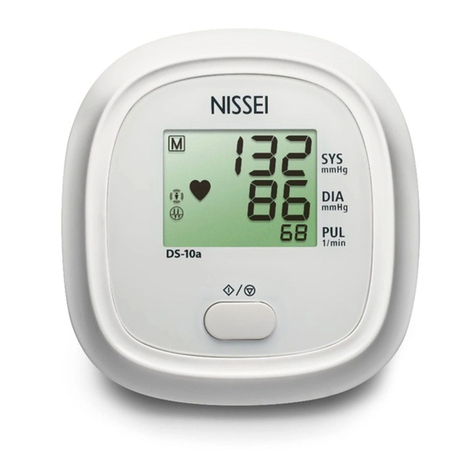
Nissei
Nissei DS-10a User manual

Nissei
Nissei DSK-1031 User manual

Nissei
Nissei WS-820 User manual

Nissei
Nissei WS-1300 User manual

Nissei
Nissei WSK-1011 User manual

Nissei
Nissei DSK-1031 User manual

